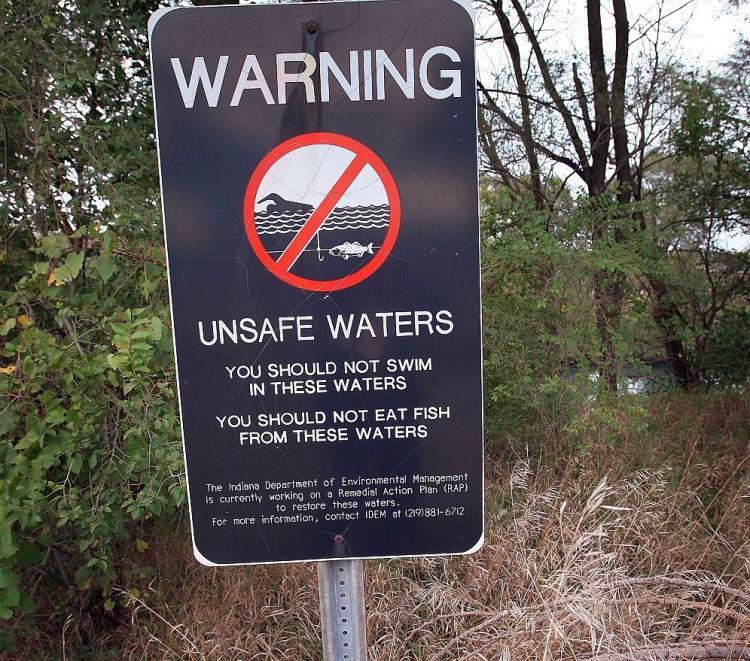Even though mercury levels in many states have dropped in recent years, some states continue to harbor dangerous levels of mercury. In Indiana, mercury levels from fish in local water samples yield levels that are too high for human and animal consumption, according to a recent Geological Survey report.
About one out of every eight fish samples taken have levels of mercury that are damaging to humans and animals. There are many causes, including fallout from snow and rain as well as what goes down drains and into the water supply.
In 2009 the Geological Survey report found that 6 percent of water samples collected from 2004 to 2006 had mercury that exceeded the Indiana water quality standards. Seventy-three percent of those samples had levels that exceed standards protecting wildlife and 80 percent of those samples had methylmercury, which is the most toxic form of mercury. The mercury in the water supply makes its way into local birds, fish, and mammals by following the food chain, which can go all the way up to humans.
The same report found 40 percent of samples from precipitation had levels of mercury unhealthy for humans. However, there was a 3 percent decrease in mercury concentrations in precipitation and an 8 percent decrease in the mass of mercury deposited by precipitation from 2001 to 2005. The surveyors believe that the decreased levels might be related to the 28 percent decreased emissions in Indiana from 2002 to 2005.
Emissions from coal burning power plants is the largest contributor to mercury levels in the air, which then reaches the surface in the form of either rain or snow. Even though levels have decreased slightly (according to the 2009 Geological Survey report) the levels are still at an unhealthy level for both wildlife and humans.
Another contributor to ground water contamination includes waste water disposal from urban areas. In the more recent 2010 study, 96 percent of waste water discharge tested included mercury. Additionally, the detected mercury was usually at levels dangerous for humans and wildlife.
“The amount of mercury in precipitation was the main factor affecting mercury levels in the state’s watersheds. But waste water discharge can be a significant source of mercury. When waste water is delivered to a stream from hundreds of discharge pipes, it increases mercury levels in watersheds more than was previously recognized,” stated Martin Risch, a U.S. Geological Survey hydrologist and study leader in a recent U.S. Department of the Interior press release.
Concentrations of mercury vary across Indiana. However, the White River near Indianapolis had some of the highest concentrations of mercury. The White River as well as Fall Creek (also near Indianapolis) had the highest levels of mercury in fish samples taken. The Patoka River area in southern Indiana had the highest rate of mercury in the form of dry deposition. The leaves on the trees of this heavily forested area act as a trap for mercury in the air. More mercury was deposited in this form than by rain deposition in this area.
The U.S. Geological Survey in conjunction with the Indiana Department of Environmental Management (IDEM) has been compiling information and reports on the condition of Indiana’s watersheds for the decade.
“Indiana has been a national leader in understanding its mercury problems through a long-term statewide network of monitoring. Actions by the IDEM provided data about mercury in fish and waste water. Our understanding of mercury would not have been possible without their cooperation,” said Risch.
About one out of every eight fish samples taken have levels of mercury that are damaging to humans and animals. There are many causes, including fallout from snow and rain as well as what goes down drains and into the water supply.
In 2009 the Geological Survey report found that 6 percent of water samples collected from 2004 to 2006 had mercury that exceeded the Indiana water quality standards. Seventy-three percent of those samples had levels that exceed standards protecting wildlife and 80 percent of those samples had methylmercury, which is the most toxic form of mercury. The mercury in the water supply makes its way into local birds, fish, and mammals by following the food chain, which can go all the way up to humans.
The same report found 40 percent of samples from precipitation had levels of mercury unhealthy for humans. However, there was a 3 percent decrease in mercury concentrations in precipitation and an 8 percent decrease in the mass of mercury deposited by precipitation from 2001 to 2005. The surveyors believe that the decreased levels might be related to the 28 percent decreased emissions in Indiana from 2002 to 2005.
Emissions from coal burning power plants is the largest contributor to mercury levels in the air, which then reaches the surface in the form of either rain or snow. Even though levels have decreased slightly (according to the 2009 Geological Survey report) the levels are still at an unhealthy level for both wildlife and humans.
Another contributor to ground water contamination includes waste water disposal from urban areas. In the more recent 2010 study, 96 percent of waste water discharge tested included mercury. Additionally, the detected mercury was usually at levels dangerous for humans and wildlife.
“The amount of mercury in precipitation was the main factor affecting mercury levels in the state’s watersheds. But waste water discharge can be a significant source of mercury. When waste water is delivered to a stream from hundreds of discharge pipes, it increases mercury levels in watersheds more than was previously recognized,” stated Martin Risch, a U.S. Geological Survey hydrologist and study leader in a recent U.S. Department of the Interior press release.
Concentrations of mercury vary across Indiana. However, the White River near Indianapolis had some of the highest concentrations of mercury. The White River as well as Fall Creek (also near Indianapolis) had the highest levels of mercury in fish samples taken. The Patoka River area in southern Indiana had the highest rate of mercury in the form of dry deposition. The leaves on the trees of this heavily forested area act as a trap for mercury in the air. More mercury was deposited in this form than by rain deposition in this area.
The U.S. Geological Survey in conjunction with the Indiana Department of Environmental Management (IDEM) has been compiling information and reports on the condition of Indiana’s watersheds for the decade.
“Indiana has been a national leader in understanding its mercury problems through a long-term statewide network of monitoring. Actions by the IDEM provided data about mercury in fish and waste water. Our understanding of mercury would not have been possible without their cooperation,” said Risch.






